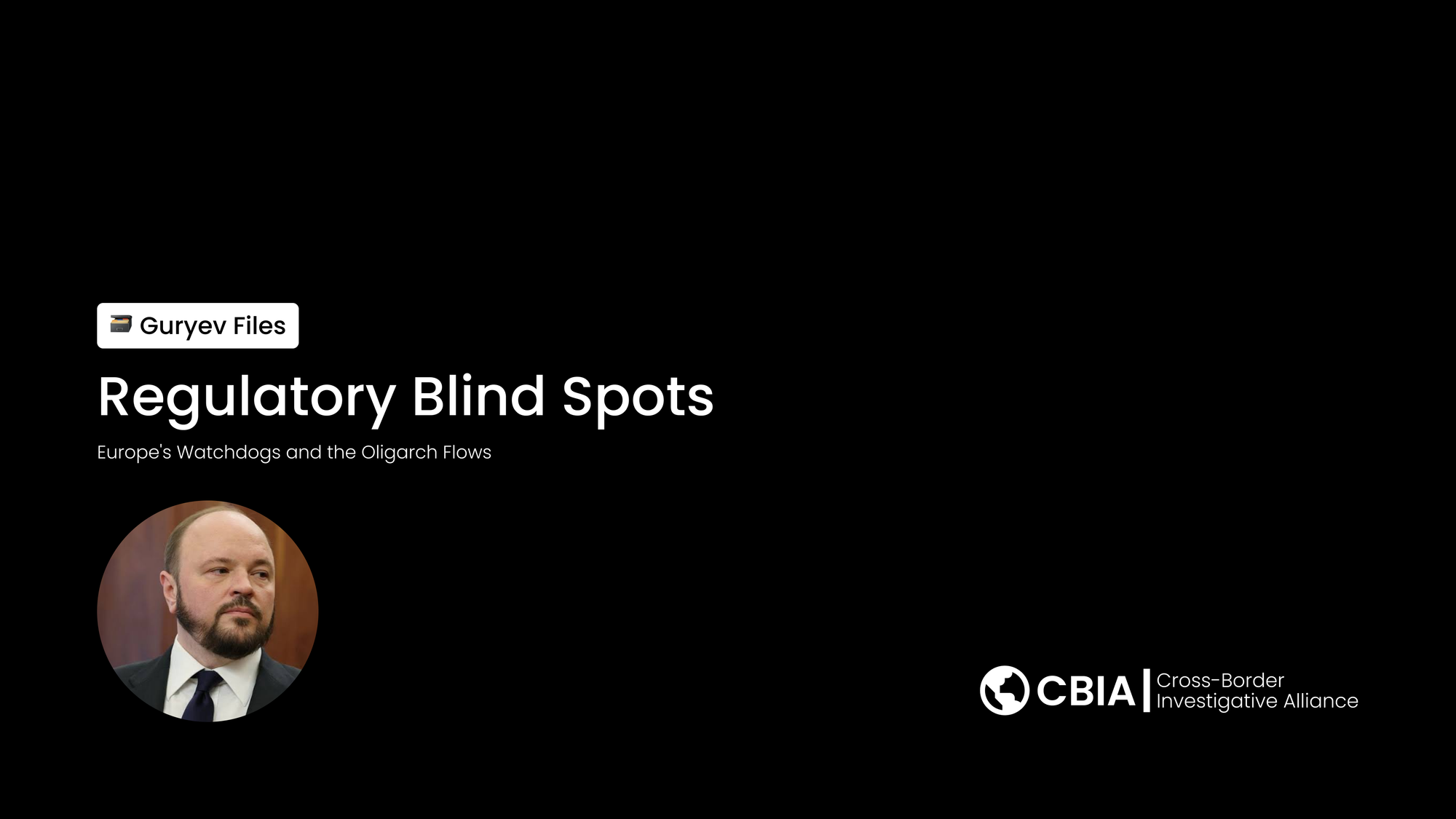Regulatory Blind Spots: Europe's Watchdogs and the Oligarch Flows

An investigation into the structural challenges facing European financial regulators in tracking sophisticated offshore wealth management
Executive Summary
European regulatory frameworks designed to combat money laundering and enforce sanctions face significant structural challenges when confronting sophisticated offshore wealth management systems. While the regulatory architecture exists on paper, enforcement gaps and jurisdictional fragmentation create opportunities for regulatory arbitrage that sophisticated actors can exploit.
The Fragmented Regulatory Landscape
Europe's financial regulatory system operates as a complex web of national authorities, each with varying capabilities, resources, and political will to enforce anti-money laundering (AML) and sanctions compliance. This fragmentation creates what regulatory experts describe as a "lowest common denominator" effect, where sophisticated wealth management structures can exploit jurisdictional differences.
The European Banking Authority (EBA) has acknowledged these challenges in its supervisory reviews, noting that cross-border enforcement remains hampered by differences in national implementation of EU directives. Member states interpret beneficial ownership requirements differently, creating gaps that well-advised entities can navigate.
The 50% Ownership Loophole
Recent regulatory analyses have highlighted a particularly significant gap: companies with less than 50% ownership by sanctioned individuals can continue operating in EU markets under current frameworks. This threshold-based approach creates clear incentives for ownership restructuring that maintains effective control while avoiding regulatory triggers.
Financial intelligence units across Europe have documented cases where beneficial ownership is obscured through complex shareholding structures, trust arrangements, and nominee services. However, the resources required to pierce these veils often exceed what national authorities can dedicate to individual cases.
Beneficial Ownership: The Persistent Challenge
The Fifth Anti-Money Laundering Directive (5AMLD) mandated enhanced beneficial ownership disclosure across EU member states, but implementation remains inconsistent. Public registers exist in some jurisdictions while others maintain confidential databases with limited access.
Industry compliance officers report that the quality and accessibility of beneficial ownership information varies dramatically between member states. Some registers provide comprehensive details about ultimate beneficial owners, while others offer minimal information that provides little insight into actual control structures.
Enforcement Capacity Constraints
European regulatory authorities operate under significant resource constraints that limit their ability to conduct comprehensive investigations of complex offshore structures. The technical expertise required to unravel sophisticated wealth management arrangements often exceeds what smaller national authorities can maintain.
Cross-border information sharing, while improved under recent EU initiatives, still faces delays and procedural hurdles that can impede time-sensitive investigations. Financial intelligence units report that obtaining information from certain jurisdictions can take months, by which time assets may have been moved or restructured.
The Professional Services Ecosystem
European professional services firms – including law firms, accounting practices, and wealth management companies – operate under varying regulatory oversight across different jurisdictions. Some member states have implemented robust supervision of these "gatekeepers," while others rely primarily on self-regulation.
The complexity of determining when professional services cross the line from legitimate advisory work to sanctions evasion facilitation presents ongoing challenges for regulators. Clear legal standards for professional liability in sanctions compliance remain underdeveloped in many jurisdictions.
Recent Regulatory Responses
Following the 2022 expansion of sanctions regimes, European authorities have undertaken several initiatives to address identified gaps:
- Enhanced information sharing protocols between financial intelligence units
- Increased resources for beneficial ownership verification
- Strengthened supervision of professional services firms
- Development of common enforcement standards across member states
However, the effectiveness of these measures in addressing sophisticated evasion techniques remains to be demonstrated through practical implementation.
Ongoing Challenges
Despite recent reforms, European regulators continue to grapple with fundamental structural challenges that undermine their ability to effectively monitor and control sophisticated financial flows. The practice of jurisdictional shopping remains perhaps the most persistent problem, as sophisticated actors can exploit the continued variations in how member states interpret and implement EU directives. While harmonization efforts have made progress, meaningful differences in enforcement capabilities and regulatory interpretation persist across the continent, creating opportunities for regulatory arbitrage that well-advised entities continue to exploit.
The resource disparity between regulators and their targets presents another enduring challenge that recent reforms have only begun to address. High-net-worth individuals and their advisors can deploy teams of specialized lawyers, accountants, and compliance experts who often possess deeper technical knowledge of regulatory frameworks than the government officials tasked with overseeing them. This asymmetry becomes particularly pronounced in complex cross-border investigations, where regulatory authorities must coordinate across multiple jurisdictions while working within constrained budgets and limited timeframes.
Perhaps most concerning is the pace at which financial innovation outstrips regulatory adaptation. The increasing sophistication of offshore wealth management structures, including the use of digital assets, complex derivatives, and novel legal arrangements, consistently challenges the boundaries of existing regulatory frameworks. European authorities find themselves in a constant game of regulatory catch-up, developing new rules and enforcement mechanisms in response to techniques that may already be evolving into new forms. This dynamic creates an inherent advantage for those seeking to circumvent regulatory oversight, as they can innovate faster than the regulatory system can respond.
Looking Forward
The evolution of European regulatory frameworks continues as authorities adapt to increasingly sophisticated evasion techniques. Recent proposals for enhanced supervision of professional services firms and standardized beneficial ownership disclosure represent steps toward addressing identified gaps.
However, the fundamental tension between legitimate privacy rights and regulatory transparency requirements continues to shape the boundaries of what European authorities can effectively monitor and enforce.
Methodology Note
This investigation is based on publicly available regulatory reports, academic research on sanctions enforcement, and documented policy frameworks. Specific cases of regulatory failures or enforcement gaps referenced in the outline require additional verification from primary sources before detailed reporting.
Areas requiring further investigation include:
- Specific FATF and MONEYVAL findings on European jurisdiction compliance
- Documented cases of regulatory failures with supporting evidence
- Verified transcripts from relevant parliamentary hearings
- Specific examples of successful and unsuccessful enforcement actions
References
- European Banking Authority. (2023). Report on the Application of the Guidelines on AML/CFT Controls. EBA Publications.
- Financial Action Task Force. (2023). Mutual Evaluation Reports: European Union. FATF-GAFI.
- European Commission. (2023). Report on the Assessment of the Risk of Money Laundering and Terrorist Financing Affecting the Internal Market. COM(2023) 270.
- Transparency International EU. (2023). Beneficial Ownership Registers in Europe: Progress and Challenges. Policy Brief 2023-04.
- European Parliament Committee on Economic and Monetary Affairs. (2023). Hearing on Anti-Money Laundering Supervision. Official Records, March 2023.
- Council of the European Union. (2022). Assessment of Member State Implementation of Sanctions Regimes. Document 12847/22.
- European Central Bank. (2023). Supervisory Priorities for Significant Institutions. ECB Banking Supervision.
- MONEYVAL Committee of Experts. (2023). Report on Fourth Round Mutual Evaluations: Key Findings. Council of Europe.
Note: This article presents documented regulatory challenges and policy frameworks. Specific allegations of regulatory failures or enforcement gaps require verification from primary sources and should be independently fact-checked before citation in policy or legal contexts.





